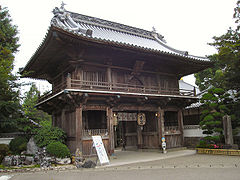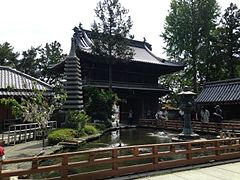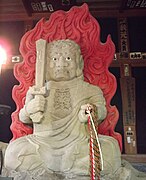Ryōzen-ji (Naruto)
The Ryōzen-ji ( Japanese 霊 山寺 ) with the Go Jikuwasan (竺 和 山) and Ichjōin (一 乗 院) is a temple of the Kōyasan direction (高 野山 派) of Shingon Buddhism in the city of Naruto in Tokushima Prefecture . The temple traditionally tops the list of the Shikoku pilgrimage route as number 1. It is therefore also called “Hatsugan no tera” (発 願 の 寺), for example “Temple of the Beginning of Prayer”.
history
According to tradition, the temple was founded by priest Gyōki at the request of the emperor Shōmu . In 815 Priest Kūkai came here on his way from the northeast and released the people from their earthly desires and performed exercises to calm the heart for 37 days. Since the area was similar to the "Holy Eagle Mountain" (霊 鷲 山) in India, he called the temple "Indian Temple in Japan" (Jikuwasen) or "Ryōzen-ji". It was a side temple of the Ōasahiko shrine (大麻 比 古 神社).
In its heyday the temple belonged to the "Three Great Monasteries of Awa" (阿波 三大 坊, Awa Sandaibō), but was destroyed in 1582 in the civil war of the 16th century by the troops of Chōsokabe Motochika . Then the temple was rebuilt by the daimyo family Hachisuka , who ruled in Tokushima, and chosen as their prayer temple . But then in 1891 the temple was ravaged by a fire that only the treasure pagoda survived. The lost structures were gradually replaced.
The attachment
After entering the temple area through the temple gate (山門, Sammon; 1), which is designed here as a tower gate, you pass the 22 m high treasure pagoda (多 宝塔, Tahōtō; 4) from the Ōei era (1394-1428) on the left. It is the only old building in the complex. Also worth seeing is the garden with a pond, which dates back to the Meiji period . On the right is the Daishidō (大師 堂; 3), which is dedicated to the temple founder Kūkai. In front is the main hall (本 堂, Hondō; 2). On the left there is a pavilion for St. Fudō (不 動 明王; 5). Next to it are the twelve stone Buddhas, to which the Fudōmyōō (不 動 明王), one of the "shining kings" (明王, Myōō), belongs (十三 仏, Jūsanbutsu; 6). Its depiction with sword and chain in front of a flame background is typical. At the northern edge of the pond, over which a bridge leads to the Daishidō, stands the " Vajra jaw" (三 鈷 松, Sanko-matsu; 7), so named after its appearance.
Treasures
The revered cult figure is of the type of the just born Shakamuni (釈 迦 誕生 仏 像, Shaka Tanjōbutsu zō), making this temple number 1 on the Shikoku pilgrimage. The figure comes from the Hakuhō period, i.e. from the time immediately before the Nara period . It is about 14 cm high and is made of bronze.
photos
literature
- Tokushima-ken no rekishi sampo henshu iinkai (ed.): Ryōzenji . In: Tokushima-ken no rekishi sampo. Yamakawa Shuppan, 2009, ISBN 978-4-634-24636-2 , p. 72.
- Oguri, Doei: Kukai. Shikoku hachijuhachi kosho no arukikata. Chukei no Bunko, 2011. ISBN 978-4-8061-4067-2 .
Web links
← Previous Temple: Ōkubo-ji | Ryōzen-ji (Naruto) | Next temple: Gokuraku-ji →
Coordinates: 34 ° 9 ′ 35.3 ″ N , 134 ° 30 ′ 9.3 ″ E








